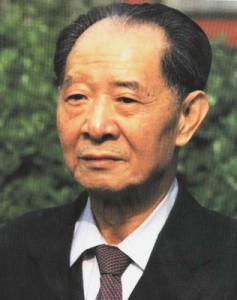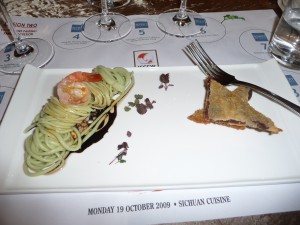Chopsticks!
I was in Singapore, for the first time, in October, as a panellist at the International Congress of Chinese Cuisine and Wine (ICCCW). I’ll be writing more about the trip later, but I just wanted to mention a small but thought-provoking incident. A young Singaporean Chinese woman came up to me during one of the conference dinners and complimented me on my use of chopsticks, saying that she was unable to use them so proficiently herself. ‘My parents never taught me how to eat with chopsticks,’ she said, ‘because they didn’t feel it was important these days. Actually this is common among my generation. Now some of the local clan associations are so concerned about this that they are running classes for the younger generation in how to use chopsticks, as well as language classes in various Chinese dialects.’
I was reminded of some famous, or infamous comments made by the open-minded General Secretary of the Chinese Communist Party, Hu Yaobang, in 1984 – he was quoted in an official magazine as saying: ‘We should stop unhealthy eating practices, encourage dividing up of food, put out a few knives, forks, buy a few plates, eating Chinese food in the Western style. In this way we can avoid contagious diseases.’
Somehow both these comments seem to me to reflect the great tragedy of China’s disconnection with its traditional culture over the past two hundred years. Chopsticks, after all, are not just some trivial, peripheral cultural ornament – they have been used in China for millennia, and they are part of a grand eating tradition in which the sharing of food that has been cut into small pieces is central. Of course you can divide Chinese food into small, individual portions and eat it with knives and forks if you want (and there are historical precedents for the former – look at old images of Han Dynasty banquets, with individual set meals, for example). But is eating with chopsticks really backward and unhygienic?
For me, there is something so elegant, minimalistic and beautiful about chopsticks. They give one a more direct and tactile contact with the food, somehow. I also like their gentleness, especially when they are made of wood or bamboo – just compare them with the barbarian violence implicit in our cold metal knives! And I’ve never forgotten how, when I was camping with some friends in a field near Songpan in northern Sichuan, our guide simply cut and peeled twigs from nearby trees to make chopsticks for dinner!
As to the hygiene, well, is using chopsticks in shared dishes really so dangerous? (are there any hygiene experts out reading this blog who might be able to weigh in on this debate?) Anecdotally, I have never been more frequently ill in China than at home in England, and I went on using chopsticks throughout the SARS epidemic. And I can’t see that it should be any more dangerous than kissing, which Westerners do all the time in greeting and which most Chinese people seem to find rather repulsive (for hygiene reasons, too?).
And if you really want to be safe, you can use gong kuai å…¬ç·, or ‘public chopsticks’, as some people tried to do during the SARS crisis, and which I noticed my Hong Kong Chinese friends doing when I was there in October. There’s no need to throw the baby out with the bathwater.




14 Responses to “Chopsticks!”
As someone who was born and spent early childhood years in that region of SE Asia, would concur that the traditional methodology used to hold chopsticks hasn’t been passed down successfully to younger generations there; in fact, I can remember sitting at a banquet table some 30 + years ago and having a cousin advise me to look at how all the adults were using chopsticks and then to compare that w/ the haphazard fashion emblematic of my age cohort at the time. It’s a memory that’s resonated over the years as I occasionally sneak a glance at other tables when eating out and seeing how this may be slipping into the category of a lost art.
Looking forward to reading your adventure(s) in Singapore and if the much vaunted fusion of cuisines was appetizing to your palate.
Hi Fuchsia,
I am just back from a business trip in the south of China and want to share with you some thoughts I had over my experience in a Haikou restaurant. Following an afternoon seminar that I gave on wine, wine service and how to sell wine in Chinese restaurant, I had a dinner in a Chaozhou restaurant which I found overall tasteless. My first impression was already very bad when I saw the waitress serving the tea in a wine glass ! And furthermore when I saw that the wine was going to be poured in a small wine glass for Ganbei purpose! Then, the first dish was served and it was a piece of beef presented with a fork and knife. So when you talk about the younger generation not being able to use chopsticks properly, I am just thinking that this generation doesn’t actually care as they think it is more classy/modern to eat with fork and knife,it gives the image that Chinese society has made huge progress over the last 40 years! I have had similar positive comments on how I use chopsticks from one colleague from Shanghai who actually seem happy to tell that she doesn’t know well how to use chopsticks. Unfortunately, this is an attitude that is quite common these days particularly in cities like Shanghai and it goes together with preferring a Starbuck coffee in a carton cup over a fragrant Wulong brewed in a Yixing clay teapot.
Gwen, I quite agree, and I also lament the lack of pride in some of the really wonderful things China has to offer. On the other hand, turning the lens back to look at myself, I would much rather go to a wine bar or a Chinese tea shop or a ‘gastro-pub’ than a traditional English pub, because I’m just not a beer-drinker, and I can’t stand drinking alcohol for hours without anything to eat besides crisps and peanuts. I never drink tea with milk, and although I like the idea of a traditional English tea, I find stuffing myself with so much sweet cakey food a bit unappealing. In London, I’d rather not eat those vague ‘meat pies’ served with ‘liquor’ in eel-and-pie shops. And of course I make my living by writing about foreign food!! Am I the equivalent of a Chinese person who drinks coffee rather than tea and uses a knife and fork?
(On the other hand, the revival of English food over the last few years makes me stupidly happy.)
Here in Japan everybody still uses chopsticks in the home and in restaurants. Actually, people here are quite amused that I (a white man from America) knows how to use chopsticks!
From the way I see them used here while dining (which is almost always family style) I can understand the problems with hygiene. Proper etiquette dictates that each dish has some sort of serving utensil, but they are rarely used, especially in the home. Often women will turn their chopsticks around and use the opposite ends to take from the dishes, but the men often don’t. Eating the western way may be a little more “barbaric”, but even when people are lazy, no one dares put their fork or spoon in the main serving dish!
As far as ideals, when Japanese people want a “foreign” experience at a restaurant or cafe, they do it 100% the foreign way, even drinking French cafe au lait out of French style bowls. Can’t say that I’d go that far. But when it comes to gohan (rice), it’s Japanese style all the way. It’s not pride, it’s just the way they think of it. I’m not sure why there is even an idea in China or Chinese cultures that traditional culture should be forgotten. Maybe the more foreigners that go to China and use chopsticks will inspire people!
I’m vegetarian and mostly vegan, and allergic to shellfish, and I do prefer it when people don’t put their chopsticks on my food when eating a meal with non-vegetarian dishes, but I try to not to insist on gong kuai or other serving utensils when eating with friends / family. My eating habits already put enough stress on others in those situations, and so far, I haven’t had any horrible allergic reactions.
I don’t really worry about it that much in terms of health / safety, though. I’m just not that much of a germophobe.
I agree that there is a profound disconnection with traditional culture in China – but I don’t think that it’s hit the use of chopsticks just yet (at least not for the laobaixing anyway). Chopstick etiquette is something that I think is being lost though – I recently interviewed a Chinese friend about this (who admits himself to be a bit picky about such things), and half the things he mentioned as awful chopstick etiquette I see people doing everyday.
As a side note, living in China I’ve found that not a week goes by without at least one person commenting that I (a foreigner) can use chopsticks. Though on the one hand this is a little bit annoying – chopsticks really aren’t THAT difficult – I think it also underscores how most Chinese people view their food and culinary culture – that is, so unique and complex that foreigners will never be able to appreciate or understand it. Sadly, many foreigners living in China rather live up to that stereotype, but for people (like me!) for whom this doesn’t hold, this idea can be something of a barrier.
My Anglo-australian wife is better at using chopsticks than I do (Singapore-born Chinese). As Hepatitis B is prevalent in Southern China, it is important that serving spoons or common chopsticks are available for sharing the food. I thoroughly enjoyed reading your books especially Shark’s fin and Sichuan Pepper. BTW, what is the name of the Hunan restaurant on Anzac Parade, Kensington, NSW Australia?
Jessie, I agree that it’s a bit annoying when Chinese people react with amazement to a foreigner’s being able to handle chopsticks – on the other hand, I can’t say I really mind being called a genius from time to time! It’s the same with speaking Chinese – one barely has to say ‘ni hao’, sometimes, to be showered with compliments on one’s linguistic brilliance. Having said that, I have to admit I’m seriously impressed when I see a Chinese mainlander enjoying cheese! And eating cheese, too, isn’t that difficult.
Richard – the name of the restaurant you are thinking of is ‘Chairman Mao’. Re. chopsticks hygiene, I should point out that, as far as I’m aware, Hepatitis B is transmitted through blood rather than saliva, so you can’t get it by sharing chopsticks.
I am Chinese and from what I know, there are many young chinese that knows how to use chopsticks. But the majority of “Singaporean” Chinese don’t. In our place we hired many singaporean staff in the past and none of them know how to use chopsticks, which i thought was quite wierd just like most Singaporean Chinese speaks English. I am a British born Chinese and I know that nearly every BBC are able to use chopsticks proficiently. So I couldn’t understand why these Chinese staff have never learnt to use chopsticks and are less knowledgeable in Chinese mannerism than us?!? I would have thought that we are more exposed to British Culture/influence than they are in Sinagporea. What really strikes me is our Malaysian-born Chinese staffs washes their mouths after dinner. I questioned them about their practices and found out that it was the strong protective influence of Malaysian culture. Then I started to think about when the Japanese invaded South Korea they banned Korean food and try to eliminate their culture making them dress like Japanese people, eat japanese food, talk in Japanese etc. Maybe because Singapore is a British Colony and when one country tries to colonise another it will sort of try and influence the people to go against their own government. Like for example in religious wars, sending missonaries abroad to win the hearts of foreign people for support and change their beliefs. I think its to do with not preserving the colony’s culture.
Hi Tom
Being Singaporean, I think I can say with relative confidence that your suggestion on why Singaporean-Chinese are not able to hold their chopsticks the right way is not the reason. When Singapore was founded, it was under the administration of the British government. Prior to that, there was no government to speak of, save for the Sultan (in Malaysia). With reference to the Singaporean-Chinese, there was therefore no need for the British to “..influence the people to go against their own government.” since Singapore was not under the purview of the Chinese government. Having said that, it is however true that a number of my friends are not able to hold their chopsticks the right way. Assuming that my friends are representative of the local Chinese population here, based on the reasons that they have given me, I would put it down to the lax attitude that the young Chinese here have towards their own culture, and having the idea that all things related to China are “un-cool”. Also, many parents do not bother to teach their children the right way to hold chopsticks either. It is more a matter of personal upbringing, than of political reasons. One more thing, why should it be weird that all Singaporean-Chinese speak English? I actually get this remark all the time. The school syllabus here are taught in English, with special language classes depending on whether you’re Chinese, Malay or Indian. What people really should be commenting on is why a good number of Singaporean-Chinese cannot speak Mandarin even though they’re Chinese. And that, to me, is a very sad state indeed.
Where I live, forks are always available, yet I often use chopsticks as a matter of choice, not upbringing, and I believe they might be the best tool/utensil for the occasion: simple as that. For example, I believe chopsticks are superior when picking a juicy and tender pickled tomato from a jar (the same goes for a cube of fermented tofu). Chopsticks are a convenient for eating salad greens, not particularly a Chinese food, or tackling “finger foods” (imagine how much money can be saved on paper napkins alone, LOL).
Fantastic books, Fuchsia, thank you so much! Wondering if you’ve ever thought of writing up on other major Chinese cuisines? It’s only 6 volumes to go. :)))
Thanks for your message Diprey! But what do you mean, only 6 volumes to go? The more I learn about Chinese food culture, the more ‘cuisines’ there seem to be. Who knows how far I’ll get in my lifetime.
Incidentally, I completely agree that chopsticks are MUCH more suitable than a knife and fork for eating salad leaves.
I was trying to make 2 points.
(i) In my very personal view, chopsticks is the world’s universal cultural heritage, not more Chinese than porcelain, a compass, or gunpowder. Therefore a mimimal chopstick practice/etiquette should be considered a world’s universal cultural requirement for an educated person, IMHO.
(ii) I was referring to the “8 classical cuisines” in China, and based on the passion and expertise I sensed while reading your books on both Chuan and Xian food, I would absolutely love to see/buy a multi-volume edition of “Classical Chinese Cuisine Styles and Applications”, by Fuchsia Dunlop. 🙂
I grew up in Singapore and spent a large part of my time in the kitchen with my Peranakan grandmother. We always dined with the fork and spoon, but ate noodles with chopsticks. And every reunion dinner, it’d be a feast with chopsticks as table settings.
Given the nature of the diverse cuisine, I think it made perfect sense to be versatile in utensils.